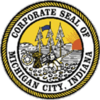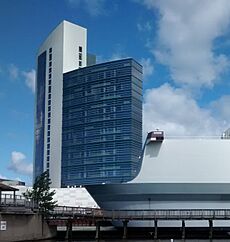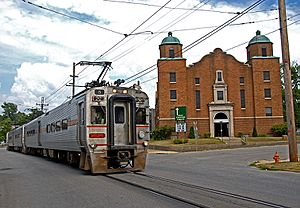Michigan City, Indiana facts for kids
Quick facts for kids
Michigan City, Indiana
|
|||
|---|---|---|---|
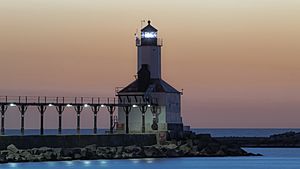
|
|||
|
|||
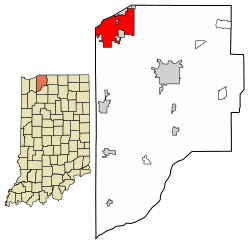
Location of Michigan City in LaPorte County, Indiana.
|
|||
| Country | United States | ||
| State | Indiana | ||
| County | LaPorte | ||
| Townships | Michigan, Coolspring | ||
| Area | |||
| • Total | 20.59 sq mi (53.33 km2) | ||
| • Land | 20.41 sq mi (52.85 km2) | ||
| • Water | 0.18 sq mi (0.48 km2) | ||
| Elevation | 633 ft (193 m) | ||
| Population
(2020)
|
|||
| • Total | 32,075 | ||
| • Density | 1,571.76/sq mi (606.87/km2) | ||
| Time zone | UTC−6 (CST) | ||
| • Summer (DST) | UTC−5 (CDT) | ||
| ZIP codes |
46360-46361
|
||
| Area code(s) | 219 | ||
| FIPS code | 18-48798 | ||
| GNIS feature ID | 2395110 | ||
Michigan City is a city in LaPorte County, Indiana, United States. In 2020, about 32,075 people lived there. It is located along Lake Michigan in the Michiana area. The city is about 45 miles (72 km) east of Chicago. It is also 40 miles (64 km) west of South Bend.
Michigan City is known for being close to Indiana Dunes National Park. It also borders Lake Michigan. Many tourists visit in the summer, especially from Chicago and nearby cities in Northern Indiana. You can travel to Chicago from Michigan City using the South Shore Line passenger train.
Contents
History of Michigan City
Michigan City started in 1830. A man named Isaac C. Elston bought the land for the city. He was a real estate investor from Crawfordsville, Indiana. He paid about $200 for 160 acres (65 ha) of land. A former school, Elston Middle School, was named after him.
The city officially became a city in 1836. By then, it had 1,500 residents. It also had a post office, a newspaper, a church, shops, and ten hotels. The city grew to 15 square miles (39 km2) in just six years. A branch of the State Bank of Indiana also opened there that same year.
Michigan City hosted the sailing events for the 1987 Pan American Games. These events took place on Lake Michigan. The main host city for the games was Indianapolis, which is about 150 miles (240 km) southeast.
Geography and Climate
City Location and Waterways
Michigan City covers an area of about 22.86 square miles (59.21 km2). Most of this area, about 19.59 square miles (50.74 km2), is land. The rest, about 3.265 square miles (8.46 km2), is water.
Trail Creek flows through Michigan City. This creek eventually empties into Lake Michigan.
Weather Patterns
| Weather chart for Michigan City, Indiana | |||||||||||||||||||||||||||||||||||||||||||||||
|---|---|---|---|---|---|---|---|---|---|---|---|---|---|---|---|---|---|---|---|---|---|---|---|---|---|---|---|---|---|---|---|---|---|---|---|---|---|---|---|---|---|---|---|---|---|---|---|
| J | F | M | A | M | J | J | A | S | O | N | D | ||||||||||||||||||||||||||||||||||||
|
2.7
31
18
|
2.4
35
21
|
2.9
46
30
|
3.6
59
40
|
4
70
50
|
4.2
79
60
|
4.3
82
64
|
4.3
81
63
|
3.6
74
55
|
3.7
62
44
|
4
48
34
|
3.2
35
23
|
||||||||||||||||||||||||||||||||||||
| temperatures in °F precipitation totals in inches source: The Weather Channel |
|||||||||||||||||||||||||||||||||||||||||||||||
|
Metric conversion
|
|||||||||||||||||||||||||||||||||||||||||||||||
The highest temperature ever recorded in Michigan City was 104°F (40°C) in 1953. The lowest temperature was -23°F (-31°C) in 1994.
The city has typical weather for a temperate region. This means it has thunderstorms in the summer and snow in the winter. Summers are often warm and humid. Because it is next to Lake Michigan, the city often gets lake-effect snow and rain showers.
People of Michigan City
| Historical population | |||
|---|---|---|---|
| Census | Pop. | %± | |
| 1850 | 999 | — | |
| 1860 | 3,320 | 232.3% | |
| 1870 | 3,985 | 20.0% | |
| 1880 | 7,366 | 84.8% | |
| 1890 | 10,773 | 46.3% | |
| 1900 | 14,850 | 37.8% | |
| 1910 | 19,027 | 28.1% | |
| 1920 | 19,457 | 2.3% | |
| 1930 | 26,735 | 37.4% | |
| 1940 | 26,476 | −1.0% | |
| 1950 | 28,395 | 7.2% | |
| 1960 | 36,653 | 29.1% | |
| 1970 | 39,369 | 7.4% | |
| 1980 | 36,850 | −6.4% | |
| 1990 | 33,822 | −8.2% | |
| 2000 | 32,900 | −2.7% | |
| 2010 | 31,479 | −4.3% | |
| 2020 | 32,075 | 1.9% | |
| Source: US Census Bureau | |||
Population in 2010
In 2010, there were 31,479 people living in Michigan City. There were 12,136 households and 7,147 families. The city had about 1,607 people per square mile (620 per km2).
About 23.5% of the people were under 18 years old. About 13.5% were 65 years old or older. The average age in the city was 37.1 years. There were slightly more males (51.4%) than females (48.6%).
Fun Things to Do and See
Places to Visit
Michigan City is home to the Old Michigan City Light. It also has a newer, working lighthouse. This is Indiana's only lighthouse.
The Pullman-Standard company, which made rail cars, had a factory in Michigan City.
You can visit Lighthouse Place Premium Outlets mall. It opened in 1987 and is an outdoor shopping center. Marquette Mall, built in 1965, was the city's only indoor mall.
Franciscan Health Michigan City is the city's main hospital. It is located near Highway 94.
Michigan City also has a zoo and an art center. The Indiana State Prison is also located here.
The city has one of the oldest active city bands in the country. They perform free concerts every Thursday evening. These concerts are held at the Guy F. Foreman Amphitheatre in Washington Park.
The eastern part of Indiana Dunes National Park is in Michigan City. Here you can find Mount Baldy, which is a large moving sand dune. Another big dune, Hoosier Slide, used to be where the power station is now. Its sand was mined in the late 1800s. The sand on the beaches near Michigan City is called "singing sand." This is because of the sound it makes when you walk on it.
The Michigan City Power Plant is along Lake Michigan. Its tall cooling tower can be seen for many miles. People sometimes mistake it for a nuclear power plant.
Michigan City has the largest riverboat casino in Indiana, called the Blue Chip Casino. In 2009, the Blue Chip complex added a 22-story hotel. This is the tallest building in northwest Indiana. Michigan City also has a new skatepark at Pullman Field.
The city has been working to improve its north end. This area has the oldest parts of the city. One idea is the Andrews Plan, which won an award in 2008. The main goal is to keep and expand the open park areas along Lake Michigan and Trail Creek.
Several places in Michigan City are listed on the National Register of Historic Places. These include the Barker House, John H. Barker Mansion, and First Congregational Church of Michigan City. Others are the Franklin Street Commercial Historic District, Michigan City East Pierhead Light Tower and Elevated Walk, and Old Michigan City Light.
Schools and Libraries
Michigan City Area Schools is the school district for the city. It includes one high school, two middle schools, and eight elementary schools.
Michigan City used to have two public high schools: M.C. Elston High School and M.C. Rogers High School. They combined after the 1994–1995 school year. Now, they are both part of Michigan City High School. This school is located at the former Rogers High School site.
There are also several private religious schools in the city. These include Marquette and La Lumiere. Some elementary schools are St. Stanislaus Kostka School, Queen Of All Saints School, and Notre Dame Catholic School.
Michigan City has its own public library, the Michigan City Public Library. The La Porte County Public Library also has a branch, the Coolspring branch, just outside the city limits.
News and Entertainment
Newspapers
The La Porte County Herald-Dispatch is Michigan City's main newspaper. It covers news for the city and nearby towns. The Beacher is a weekly newspaper based in Michigan City. It covers several local areas.
Larger newspapers like the Chicago Tribune and South Bend Tribune are also available. Off the Water is a free weekly newspaper about art and entertainment. It is distributed in downtown Michigan City.
Radio and TV
Michigan City is in the Chicago TV and radio market. This means you can get radio and TV broadcasts from both Chicago and South Bend.
The city has one FM radio station, WEFM FM 95.9. It also has one AM radio station, WIMS AM 1420.
Michigan City has a local government TV station called Access LaPorte County. The local school system (MCAS) also operates its own channel.
Getting Around Michigan City
Train Travel
Michigan City is an important stop on the South Shore Line. This is one of the last interurban train lines in the U.S. Until 2021, the train ran directly on 11th Street, sharing the road with cars. It had two stops downtown: 11th Street and Carroll Avenue. This train line connects Michigan City to downtown Chicago to the west. It also connects to the South Bend Regional Airport to the east.
Before April 2022, Amtrak trains also stopped in Michigan City. These Wolverine trains traveled between Chicago and Detroit/Pontiac. Now, Amtrak trains pass through without stopping. The closest Amtrak station is in New Buffalo, Michigan, about ten miles away.
Bus Services
Michigan City has its own bus service called Michigan City Transit. It has four routes that run Monday through Saturday. All routes start at the Michigan City Public Library. They travel around the city in loops and return to the library. One route connects to the Carroll Avenue South Shore Line station. Other routes connect to the 11th Street station. Michigan City also offers a Dial-a-Bus service.
A bus service called Indiana Airport SuperSaver used to stop in Michigan City. It traveled between The University of Notre Dame and O'Hare airport in Chicago. This service stopped running in January 2020.
Air Travel
Michigan City Municipal Airport has a 4,100-foot (1,250 m) asphalt runway. It has about 118 flights per week.
For commercial flights, people use the South Bend International Airport in South Bend. The South Shore Line train goes directly to the South Bend airport. There is also a train stop that serves the Gary airport.
Famous People from Michigan City
Many interesting people have connections to Michigan City:
- Jean Baptiste Point du Sable is known as the first permanent resident of Chicago. He lived near Michigan City in 1779.
- Daniel D. Bruce was a Marine who received the Medal of Honor for his bravery in the Vietnam War.
- Howard G. "Ward" Cunningham is a software developer. He invented the word and idea of the "wiki".
- William C. Eddy was a Naval officer, engineer, and educator.
- Marilla Waite Freeman was the first librarian of the Michigan City Public Library.
- Jarrod Jones is an American-Hungarian basketball player.
- Dan Meyer is a famous sword swallower and Guinness World Record holder.
- Allan Spear was a U.S. historian and politician. He was an early supporter of gay rights.
Actors
- Charles Arnt, actor
- Anne Baxter, an Academy Award-winning actress
- Rati Gupta, a dancer and actress known for her role as Anu in The Big Bang Theory.
Writers and Journalists
- Alvera Mickelsen, a writer and journalism professor.
- Achy Obejas, a writer and journalist.
- Amy Spindler, a fashion critic for The New York Times Magazine.
Politicians
- Naomi Anderson, a black suffragist who worked for women's right to vote.
- Richard G. Hatcher, a former mayor of Gary, Indiana.
- David E. Lilienthal, who chaired the U.S. Atomic Energy Commission.
- Zeola Hershey Misener, a suffragist and one of the first women elected to the Indiana General Assembly.
Sports Figures
- Braden Fiske, a football player for the Los Angeles Rams.
- Abe Gibron, a football player and coach for the Chicago Bears.
- Harry Hebner, an Olympic swimmer and water polo player.
- Anita King, a racecar driver and actress.
- Don Larsen, a Major League Baseball pitcher.
- John Parry, a former National Football League official.
Artists and Musicians
- Charles Freeman Lee, a jazz trumpeter.
- Rosemary Sebert, a singer and songwriter, and mother of the singer Kesha.
See also
 In Spanish: Michigan City (Indiana) para niños
In Spanish: Michigan City (Indiana) para niños



